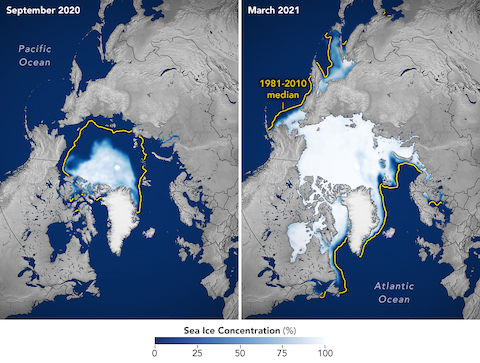
For 500 years, explorers have looked for a passage above North America, from the Atlantic to the Pacific.
With a warming Arctic, they’ve finally got it. Which could have profound impacts on geopolitics.
In the 1500s, Spain and Portugal controlled the sea routes to their colonies in the Americas. Northern Europeans, looking for their own way to reach Asia, began searching for a Northwest Passage through frigid Arctic seas.
For centuries, voyagers endured winters frozen in ice, where entire crews died. Finally, in 1903, the Norwegian explorer Roald Amundsen, who was also first to the South Pole, picked his way through in a shallow-draft fishing boat, with a crew of just 6. But this was hardly a trade route.
In the last 10 years, summer ice in the Arctic has shrunk to its lowest volume since humans have measured it, finally opening a passage for cargo ships and tankers.
With this access, many nations have laid claim to the Arctic seas that touch their northern shores—and the rich mineral resources beneath them.
Russia is particularly interested in the oil there, thought to be 25 percent of the world’s remaining resource.
If ice continues melting, we may see an ice-free Arctic in 20 to 30 years. And growing international tensions as countries jockey for control.
It’s a new frontier, which could alter the balance of power in the Northern Hemisphere.
Background
Synopsis: In 1492, when “Columbus sailed the ocean blue” in search of Asian ports, he ran into a big problem: North and South America were in the way. Countless treacherous voyages searched for the fabled Northwest Passage around the Americas starting in the 1500s. As the Arctic region warms, the passage is finally revealing itself seasonally, raising questions about who owns the Arctic seafloor and its riches, as well as luring tourists on cruise ships with icebreaker escorts.
- Attracted by the lure of a maritime route to Asia, seafarers have searched for the Northwest Passage for the past 500 years.
- As early as the second-century AD, the Greek scholar Ptolemy imagined a frigid ocean, Mare Glaciale, toward Earth’s North Pole.
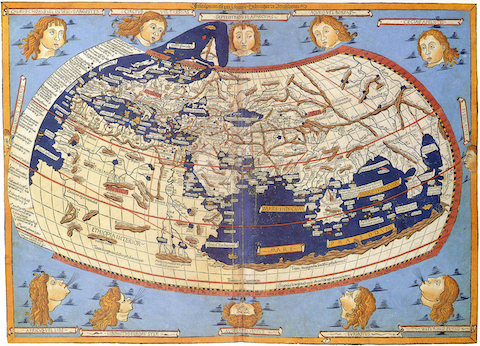
A 1482 world map by Leinhart Holle derived from rediscovered Greek manuscripts of Ptolemy's second-century Geography. Credit: Lord Nicolas the German (Donnus Nicholas Germanus), cartographerJohann the Blockcutter of Armsheim (Johannes Schnitzer or Johannes de Armssheim), engraver Ptolemy Jacobus Angelus, translator, via Wikimedia Commons - After the voyages of Columbus, the Spanish and Portuguese gained control of the trade routes along the South American and African coasts.
- Dutch, English and French explorers believed a Northwest Passage around North America would enable them to access Asian ports, so set out to find one.
- Maps of the treacherous region became important, and some maps were deliberately deceptive to lead competitors into danger.
- As early as the second-century AD, the Greek scholar Ptolemy imagined a frigid ocean, Mare Glaciale, toward Earth’s North Pole.
- The most infamous expedition was the doomed 1845 voyage of British Naval Captain Sir John Franklin.
- Franklin set out in 1845 with 129 crew on two ships, the H.M.S. Erebus and the H.M.S. Terror, but, unfortunately, their voyage coincided with one of the last cold snaps of the Little Ice Age.
- The ships were trapped in the ice in September 1846 and abandoned in 1848.
- Gradually, all 129 crew members perished, although rescuers searched the area for 11 years after their disappearance.
- The ships were recently discovered in Queen Maud Bay about 60 mi (96 km) south of the search area, possibly moved by the crew during a summer.
- Finally, Norwegian polar explorer Roald Amundsen navigated the Northwest Passage from 1903–1906 on the shallow-draft fishing vessel Gjøa with a crew of six, but it took three years and two winters frozen into the ice.
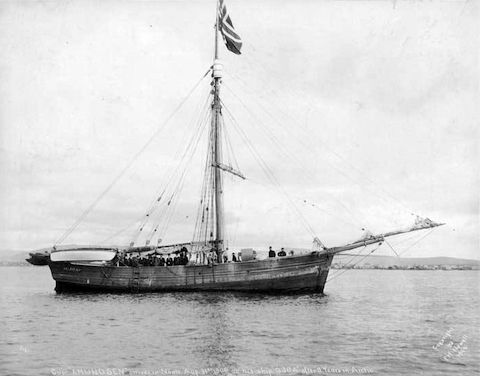
Roald Amundsen was the first to navigate the Northwest Passage entirely by boat, arriving at Nome, Alaska on August 31, 1906. Credit: Frank H. Nowell Photograph Collection, 1901-1908. ASL-PCA-48, via Wikimedia Commons - This decade, the extent of sea ice in the Arctic expanse has been the lowest since imagery has been available over the past 40 years.
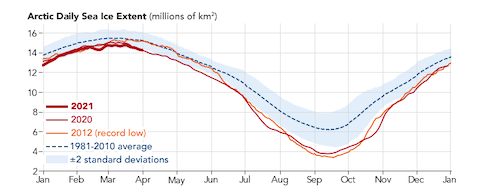
Extent of sea ice in 2012, 2020 and 2021 compared to 1981-2010 average. Credit: Shipping Responds to Arctic Ice Decline | NASA Earth Observatory - Some researchers believe the Arctic will be ice free sometime between 2040–2050.
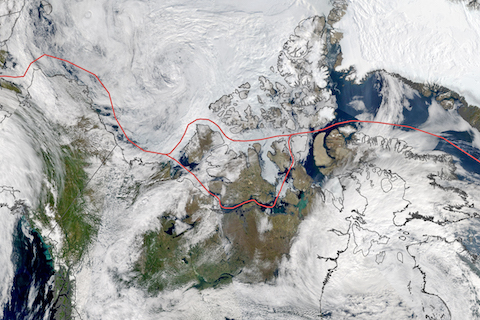
On August 22, 2021 ice still blocked the Northwest Passage. Credit: Ice Persists in the Northwest Passage | NASA Earth Observatory - Shipping traffic has increased dramatically, with the center of activity moving north and east, toward the North Pole.
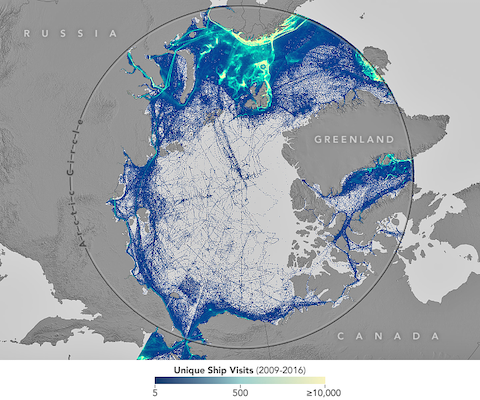
Lines on this map show the beacon locations of unique ship visits to Arctic waters between September 1, 2009 and December 31, 2016. Denser and brighter coloring indicates a larger number of ship transits. Credit: Shipping Responds to Arctic Ice Decline | NASA Earth Observatory - In 2013, the Nordic Orion, carrying a load of coal, was the first bulk cargo carrier to cross the passage.
- In August 2016, at $22,000 to $120,000 per person, plus $50,000 emergency insurance coverage, the Crystal Serenity luxury cruise liner left Seward, Alaska, arriving in New York a month later.
- Some researchers believe the Arctic will be ice free sometime between 2040–2050.
- Now, tankers with hardened hulls are travelling through the Arctic without accompanying icebreakers.
- It took just 19 days for an August 2017 tanker trip from Norway to South Korea, about a week faster than a trip through the Suez Canal.
- An LNG tanker travelled from South Korea to northern Russia to France in February 2018.
- Accessibiity has once again raised the question: who owns the Arctic?
- Commercial trade routes that save transit time continue to increase in value.
- The USGS estimates that 25% of the world’s remaining oil and gas resources might occur below the Arctic seafloor.
- In 1945, the United States claimed jurisdiction to the edge of its continental shelf, and other nations reacted by claiming resources and fishing grounds based on a variety of definitions, creating a tangled mess of jurisdictional boundaries.
- In 1982, the UN stepped in to normalize the claims to maritime activities. The Law of the Sea Treaty was signed by more than 150 nations.
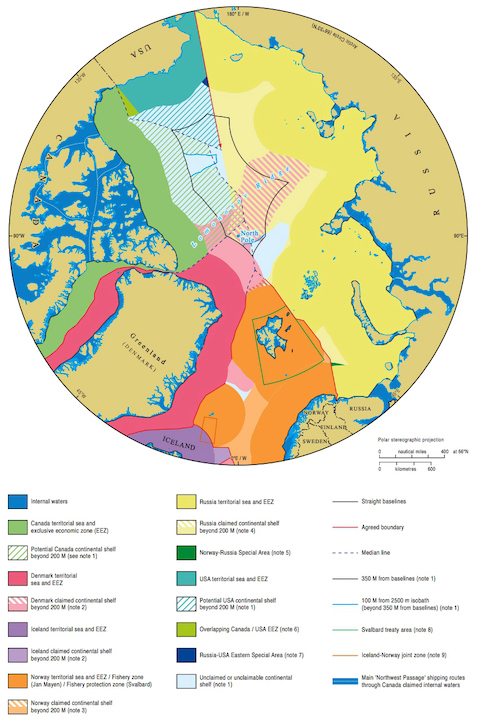
Arctic jurisdictional claims in 2015. Credit: Durham University’s Centre for Borders Research (IBRU) - Each country has exclusive rights to resources within 230 mi (200 nautical mi or 371 km) of its natural shoreline.
- Additionally, countries can extend their claim to 402 mi (350 nautical mi or 648 km) from their shoreline if they can prove these areas are extensions of their continental shelf, bringing geology into the equation.
- Arctic contender countries are actively remapping the seafloor to document claims, especially along the Lomonosov Ridge that runs from Russia’s New Siberian Islands to Canada’s Ellesmere Island, adjacent to Denmark’s territory of Greenland.
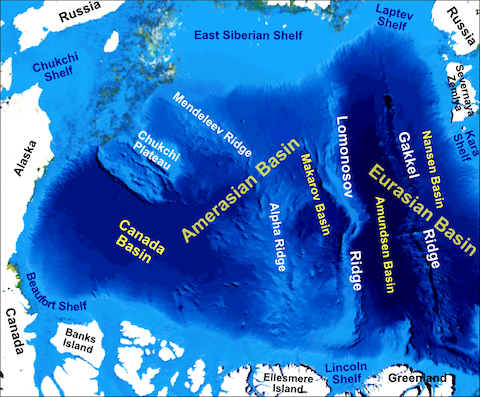
Bathymetric features of the Arctic Ocean. Credit: Mikenorton, CC BY-SA 3.0 <https://creativecommons.org/licenses/by-sa/3.0>, via Wikimedia Commons - The country that can demonstrate that the Lomonosov Ridge is an extension of their continental shelf can claim the central part of the Arctic Ocean and all its resources, and that is a really big deal! Will it precipitate a really cold war?

